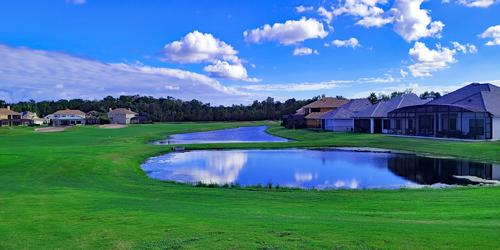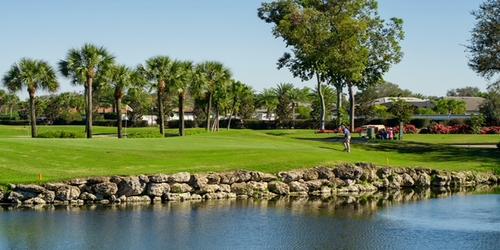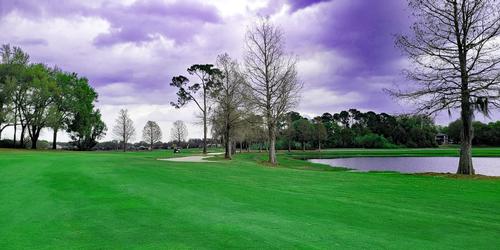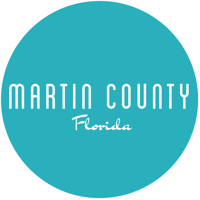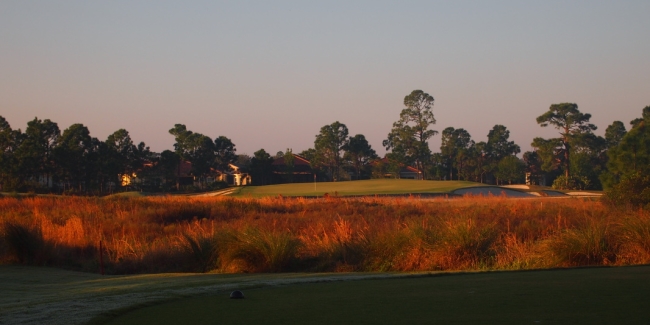
PGA Village - Wanamaker Course
By David Theoret
set up a good approach shot on the Wanamaker Course. The greens are well-guarded by sand and, on many holes, water.
The wet stuff is visible on just about every hole, and affects either tee shots or approaches on at least 10 holes. Several times you will find yourself with challenging carries from the back tees over natural wetlands. There are a lot of sand bunkers of all shapes and sizes along the sides of the fairways as well as surrounding the green. When you combine the sand, with all of the water and tropical foliage on the course, you are left with a visually stunning and challenging golf experience.
The majority of the green complexes are elevated, eliminating the possibility of bump and run. There are few, if any flat putts; the putting surfaces are well undulated and often protected by rolling mounds and deep lipped bunkers.
Memorable Holes (All yardage is from the Gold Tees):
Number 1: Par 5, 519 yards. If your warm up went well on the range, then you should be ready for this par 5 to get your round started. It's a slight dogleg left however the dogleg doesn't really come into play until your layup shot. The large fairway bunkers on the left side can come into play from any tee box. Woods on the right are definitely within reach off the tee. The fairway is wide open on your layup shot however be sure to keep the ball right; there is a very deep bunker on the left side that makes par much more difficult. The approach shot is slightly up hill to a well guarded, two tiered green which has a long, narrow bunker on the right side and a deep, nasty pot bunker on the left. The green is long and narrow; a back pin placement could be a two club difference from a front pin. Par is a great start on this fabulous Fazio opening hole.
Number 2: Par 4, 426 yards. This is the #1 handicap hole on the Wanamaker Course; it's a straight par 4 with water on the left which shouldn't come into play unless you hit a wild hook. This same water will become very prominent on your approach shot as it guards the left side of the green. Two large, deep (about 8 feet deep) bunkers on the right side are definitely in play off the tee. Anything left is bound to be among the mounding that makes up this side of the fairway as well as mounding up the left can lead to an interesting lie. A couple of small bunker to the left of the large, undulating green make this a great golf hole.
Number 4: Par 3, 195 yards. This hole is one of the few forced carries on the course, and it's not that long of a carry. Depending on pin placement, the hole will play around 200 yards to a large, elevated green. It is surrounded on all sides by bunkers; one of which is a large waste bunker front left.
Number 5: Par 4, 356 yards. No trouble on this hole; except for the small lake all the way up the left side. You will also find mounding one either side of the fairway. Your approach shot is to a long, elevated green which could be a two club difference depending on pin position.
Number 6: Par 3, 165 yards. I think this is the prettiest hole on the course. It's a slight downhill par 3. With the water on the left, a pin placement in the back, left part of the green is definitely a "sucker" pin; you would have to drop the ball over a large sand trap on the left side to a very small part of the green with water long. The hog's back running through the middle of the green makes it hard enough without a back left pin.
Number 9: Par 4, 404 yards. This is one of the few holes on the outward nine where water really isn't in play off the tee unless you absolutely bomb it down the right side. There is a massive waste bunker that lines the left side of the fairway and ends with a large bunker with grass mounds in it. Your approach shot is to an elevated green that is guarded on the right by a deep bunker; anything right of the sand is most likely wet. A par is a good way to end the nine and gain some momentum heading into the back nine.
Number 10: Par 4, 371 yards. This straight par 4 is the narrowest hole thus far on the course. There is water on the right that should not come into play although the fairway bunker on the same side can be easy to reach. Your approach shot is to an elevated green that sits about 4 feet above the fairway. The green is flanked with large deep bunkers and is accentuated by a nasty little pot bunker right and short of the green. The green itself has a false front; anything that lands here is likely to roll back to you.
Number 11: Par 3, 168 yards. Anything right is wet. From an aerial view, the green is shaped like a mushroom. Sand guards the right side of the "stem" and two others guard the top of the "cap." Anything left of the green is most likely to be among the moguls. Par is not a bad score here, believe it or not.
Number 13: Par 5, 493 yards. As you are standing on the tee box surveying the hole, you will notice what looks to be a mountain of sand off in the distance. After you hit your drive and are contemplating your layup shot, this mountain of sand is exactly that; a bunker with about an 8 foot lip on the front of it; perhaps the most penalizing bunker on the course. The savvy golfer will avoid it at all costs; it's about 100 yards short of the green. If you play your tee shot down the right side taking Mt. Bunker out of play, you can have a go at the green in two. More sand flanks the green on the right side. If you can avoid Mt. Bunker, this hole can yield a good score.
Number 15: Par 4, 349 yards. Not the longest hole, but one of the trickiest on the Wanamaker course. It's sort of a double dogleg however a good drive will eliminate one of those doglegs. You want to hit your tee shot left of the deep pot bunker in the middle of the fairway. If you can make it to the top of the ridge off the tee, you'll be looking at an approach shot of about 120 - 130 yards. If you are going to miss your approach shot, be sure to miss it left. Anything right of the green will most likely find the sand that sits about 10 feet below the green. Although a short hole, pars can be hard to come by on this hole.
Number 18: Par 4, 427 yards. Number 18 is a spectacular finishing hole with an approach shot that is sure to test your mettle. For starters, it's fairly long at 427 yards. Throw in a waste bunker that stretches all the way down the right side and is followed up with a lake that covers the last 150 yards of this hole and you've got a real test on your hands. Anything right is in the waste bunker and leads to an approach shot out of sand with a carry of about 160 yards to an elevated green fronted by a deep pot bunker. Of course the more conventional albeit less trying rout is to keep the ball left and take the water out of play; but what fun is that?
Last Word: This is not your typical Florida golf course. Mounding in, on, and around the fairways leads to uneven lies. There is no over abundance of palmettos and there seems to be more pine trees than palm trees.
Most golfers that have played all three PGA Village courses would say that the Wanamaker course is the toughest course; I disagree but that is a discussion for another time.
Unlike most Florida courses, the Wanamaker course is not dominated by water. For the most part it is on the periphery and is usually found by errant shots. If you have any shot making ability at all, water should not be an issue.
There are virtually no forced carries of any significant length; a bigger problem on the Wanamaker is the sand. The bunkers are exactly what they should be, penalizing.
The greens are a special treat; no flat, Florida greens here. For the most part they are elevated; some such as the green on number 15 can sit 10 feet or so above the fairway. There are a number of two-tiered greens as well as a few that, depending upon pin placement, can be a two-club difference. I found a few of the greens particularly tough to read; breaks that didn't seem to be there were breaking as much as two feet. On this particular day, they were very slow, probably a result of too much rain combined with scorching temperatures.
The Wanamaker course will provide a challenge for golfers of all abilities. All three PGA Village courses are a "must play" if you are in the Port St. Lucie area. The staff is friendly and knowledgeable and treats you like royalty. The practice facilities that are available to daily fee golfers are second to none. For more information about PGA Village and what they offer, you can visit them online at www.pgavillage.com or give them a call at (800) 800-GOLF (4653).
Revised: 02/12/2014 - Article Viewed 29,590 Times
- View Course Profile
About: David Theoret
![]() David Theoret has been in the golf and golf travel industry for over 10 years, primarily selling online advertising. For the past seven years, he has also been a golf writer, reviewing golf courses, resorts, destinations, equipment, golf apparel, and training aids - the latter of which never seems to help. David's articles and reviews have been posted on many golf travel and equipment websites.
David Theoret has been in the golf and golf travel industry for over 10 years, primarily selling online advertising. For the past seven years, he has also been a golf writer, reviewing golf courses, resorts, destinations, equipment, golf apparel, and training aids - the latter of which never seems to help. David's articles and reviews have been posted on many golf travel and equipment websites.
Growing up in Southwestern Ontario, Canada, it was naturally assumed he would play hockey. Beginning at the age of 3 and continuing into his late 30's, he did just that. However, after one too many pucks to the head, he realized that golf was a lot easier on the body (whoever said hockey players were slow) and took the game up.
After moving to Florida and accepting a position with TravelGolf Media (now part of GolfNow) his love for the game grew exponentially. Most Saturdays you will find him on a course somewhere in Florida or on the practice range reinforcing his bad habits. David plays to a 10 handicap - unless there is money involved in which case it goes considerably higher. He currently resides in Lakeland, FL with his wife Belinda and their two "kids", Madyson and Molly.
Contact David Theoret:
GolfTrips.com - Contributor





